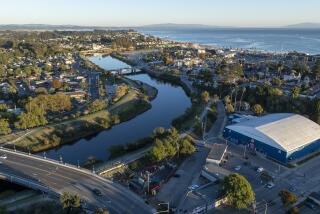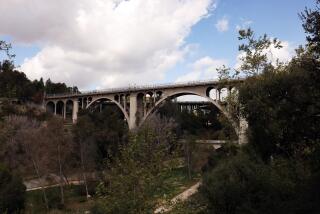Scholar Traces Names of Santa Cruz County : From Sugar City to Beer Can Beach
- Share via
SAN FRANCISCO — The name of a place always gives you a telling glimpse of its religious, ethnic, political, geologic, botanical or whimsical background.
Watsonville was named for Texan Judge John H. Watson who lived there for a dozen years around 1851, the year the town was incorporated. The settlement earlier had been called Pajaro, for the river that ran through it. And later it was dubbed Sugar City, when Claus Spreckles operated a sugar beet refinery there before the turn of the century.
Watsonville is one of the 2,314 places listed in “Santa Cruz County Place Names,” a 624-page catalogue compiled by Donald T. Clark and published by the Santa Cruz County Society for Historical Preservation.
Origin of Hepsidam
Hepsidam was the name of an area along Bean Creek adjacent to Mount Hermon on the north side of the Felton-Scotts Valley Road. Years ago, Dr. Frank Kittredge, a well-known citizen of Santa Cruz, was persuaded by his wife to move out to the country.
She was “a woman of notable character and rare good taste, fond of reading, and with a keen and genial sense of the ludicrous,” writes Clark. She often quoted to her husband from one of the mock “hard-shell Baptist” sermons written by William F. Brannan, the artist and poet.
Let us gnaw a file and flee to the mountains of Hepsidam
Where the lion roareth
And the whangdoodle mourneth its firstborn.
Hepsidam doesn’t mean anything at all, according to Clark. The name is now forgotten. Clark found it in an August, 1886, issue of the Santa Cruz Surf and on maps published in 1880 and 1902.
Moving along to current history in Santa Cruz County, Beer Can Beach is the name given by local high schoolers to a small beach on the Monterey Bay coast in the Rio del Mar-Seascape area.
Clark’s book is likely to remain the definitive work on place names in Santa Cruz County, and so historians in the far distant future may find in this book the answer to why this beach got this name. It is legitimized, he says, by current newspaper references and by the common usage of the local constabulary in referring to the site of frequent beer parties.
A Trivia Buff
“I am not a scholar. I am a trivia buff,” Clark says in his author’s introduction.
However, a scholar he is, and a charter member in the American Name Society.
Clark came from the East and settled in Santa Cruz in 1962 when he took a position as librarian at the University of California campus there.
“Santa Cruz County Place Names” is more fun as trivia than as serious history. For example, the author, while including only a few names of streets, lists one short stretch of road that was once called Cockeyed Charlie Road.
“An insignificant former street that has completely lost its identity,” he says, but “I found no other way in which I could include the story of one of the county’s most colorful characters.”
It was named for Charley Darkey Parkhurst, “a legendary, rough, stage coach driver, with a black patch over the left eye, who became well-known for exploits in the Sierra Nevada and in the Santa Cruz, Watsonville and San Juan Bautista area.
Under the listing of the road name, Clark relates, “Upon Parkhurst’s death it was discovered that he was a she.” Her grave is marked: “Charley Darkey Parkhurst 1812-1878. Noted Whip of the Gold Rush Days. Drove Stage over Mt. Madonna in Early Days of Valley. Last Run San Juan to Santa Cruz. Death in Cabin near the 7 Mile House Revealed ‘One Eyed Charlie,’ a Woman. The First to Vote in the U.S. Nov 3, 1858.”
Clark’s book has been beautifully published, 624 pages, 21 maps, by the Santa Cruz Historical Society--$37.35 cloth, $6.70 paper.
More than 1,000 copies were sold in the first two months and the book has been hailed by local historians and by professionals in the literature of place names throughout the country.
Roger Payne, assistant executive director of the United States Board on Geographical Names congratulated Clark for “an excellent piece of research.”
More to Read
Sign up for Essential California
The most important California stories and recommendations in your inbox every morning.
You may occasionally receive promotional content from the Los Angeles Times.













